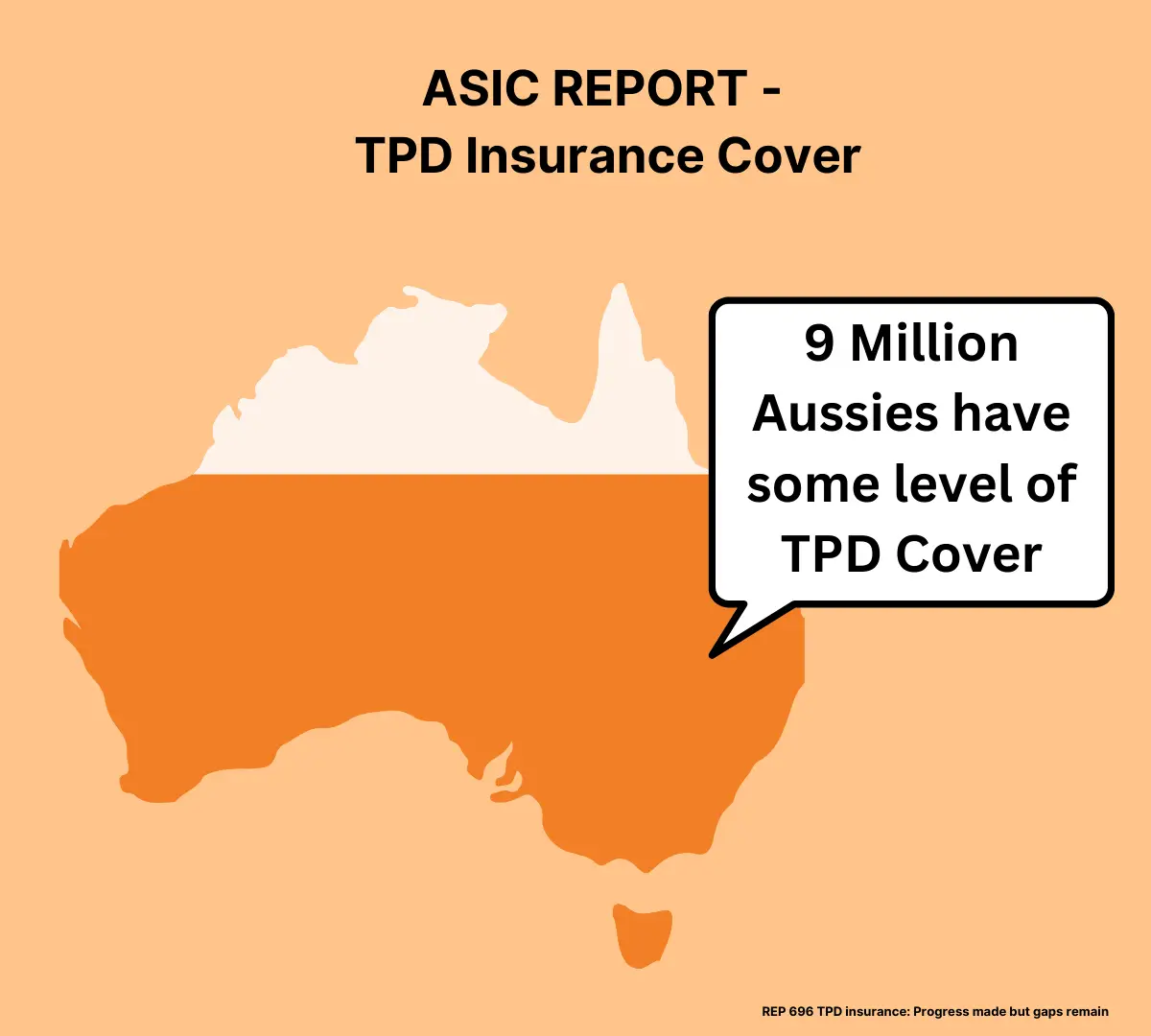How Much TPD Insurance Do I Need?
Deciding how much Total and Permanent Disability (TPD) insurance you need can feel overwhelming, but taking the time to understand your options could be a game-changer for your financial future.
TPD insurance is meant to provide financial security if you’re unable to work due to injury (either psychological or physical) or condition (such as diabetes or multiple sclerosis), but figuring out the right amount for your unique situation takes careful thought.
Asking How much TPD insurance do I need? is a common question, and affects all working Aussies. A recent ASIC report identified that approximately nine million Australians hold Total and Permanent Disability (TPD) insurance, with about 86% of these policies provided through superannuation funds.
Our TPD lawyers here share essential insights to help you plan ahead if you ever need to make a TPD claim. By understanding these tips, you can improve your chances of securing a TPD payout amount that will safeguard your future.

Understanding TPD Insurance and Its Purpose
It’s easy to underestimate how quickly an injury or condition can change your life. TPD insurance is there to help cover ongoing costs if you can’t work again, and that might mean paying off your mortgage, covering medical expenses, or just managing day-to-day living costs. But how do you decide how much is enough?
Many people wonder, “Is there a perfect number for everyone?” The truth is, there isn’t. Your ideal TPD cover depends on factors specific to your life, family, and financial responsibilities. Most of the time, people find out what TPD is once they need to make a TPD claim. By that time, it may be too late to increase your TPD cover.
Key Factors to Consider for Your TPD Insurance Amount
When figuring out how much TPD insurance cover you need, take a moment to really think about your life and the people who depend on you. Consider these factors carefully to make sure you have the right amount of cover in place.
Your Financial Commitments
Start by looking at your financial obligations. Think about your mortgage, car loans, credit card debt, or any other long-term financial commitments. You might want to ask yourself:
- Would my family be able to manage our debts without my income?
- How much of these debts would need to be cleared if I were permanently unable to work?
Daily Living Expenses
Consider your ongoing living expenses. This includes groceries, utilities, school fees, and general family expenses. The last thing you’d want is for your loved ones to struggle with day-to-day costs on top of the emotional stress of your situation.
A common rule of thumb is to ensure your TPD cover can support at least a few years’ worth of living expenses, but it’s essential to personalise this based on your family’s needs.
Future Financial Goals
Think about your financial goals for the future. Do you want to make sure your children’s education is covered? Are there other long-term savings goals you want to protect? Your TPD insurance should ideally support these plans, even if you’re no longer able to contribute to them.
TPD Amount - Evaluating Your Income and Current Lifestyle
How Much Income Do You Need to Replace?
If your income is necessary for your household’s financial stability, your TPD insurance might need to replace a substantial portion of it. Consider your annual income and how many years you would want your insurance to cover.
- If you’re younger, you might want a more extensive cover, as you could have many working years ahead of you.
- For older individuals, this could mean a smaller cover, as there may be fewer earning years left.
Cost of Medical Care and Rehabilitation
The cost of medical care can often be overlooked when planning for these scenarios. Being eligible for a TPD payout likely means you’ll face a long road of medical treatment and rehabilitation—expenses that can add up quickly.
While Australia’s healthcare system covers many medical needs, it doesn’t cover everything. Rehabilitation, home modifications, and specialist treatments can be surprisingly costly. It’s important to think about these potential expenses now and factor them into your TPD cover, so you and your loved ones have the financial protection you need when it matters most.

Calculating Your TPD Insurance Needs
As a basic method to calculate your TPD Insurance needs, consider these steps:
- Total Financial Needs: Add up everything you’d need to stay financially secure, like debts, living expenses, and income needs.
- Subtract Existing Assets and Income Sources: Subtract any assets or income sources you already have, like savings or other insurance payouts.
- Determine Coverage Amount: The result is the amount of TPD insurance coverage you may require.
Everyone’s situation is different, though, and there may be other factors to consider. Things like your family’s future plans, potential medical expenses, or unexpected costs could all come into play. It’s important to think about your unique needs and adjust your coverage accordingly.
You can find more about the average TPD payout amounts here.
Example Scenario - Jane's TPD Insurance Amount
Let’s consider an example to put this into perspective. Suppose Jane, a 35-year-old professional living in Sydney, earns $100,000 annually. She has a mortgage balance of $450,000, two young children, and dreams of sending them to private school.
Here’s how Jane works through the calculation:
Total Financial Needs: Jane adds up everything she’d need to keep her family secure:
- Mortgage: $450,000
- Children’s education: $200,000
- Living expenses (for at least five years): $300,000
- Medical and unexpected costs: $100,000
Total Financial Needs: $1.05 million
Subtract Existing Assets and Income Sources: Jane has $80,000 in savings the she has stored in her mortgage offset account. She subtracts this amount from her total financial needs:
Adjusted Amount: $1.05 million – $80,000 = $970,000
Determine Coverage Amount: After doing the math, Jane realises she needs about $970,000 in TPD insurance coverage. This amount would help pay off her mortgage, cover her kids’ education, and keep her family financially secure if she’s ever unable to work and makes a TPD claim.
To see other examples, you can read about real TPD claim success stories here.
How Can I Check My Current Level of TPD Cover?
If you’re thinking about getting TPD cover, the good news is that most Aussies already have some level of cover included in their superannuation. Checking your current TPD cover is straightforward and can give you a clearer idea of what protection you already have in place. This way, you can decide if you need to top up your coverage or if your existing insurance is sufficient to meet your needs.
- Log Into Your Superannuation Account: Start by logging into your super fund’s online portal. Most super funds provide detailed information about the types of insurance included with your account, including TPD cover.
- Review Your Insurance Details: Once you’re logged in, look for the section that outlines your insurance policies. Here, you’ll typically find details about your TPD cover, including the amount insured and any relevant terms or conditions.
- Contact Your Super Fund Directly: If you’re unsure or want a more in-depth explanation, it’s worth contacting your super fund. They can explain your coverage and help you understand how it works, including any limitations or exclusions that may apply.
- Check Your Annual Statement: Your annual superannuation statement should also list your TPD insurance details. Review this document carefully to ensure you’re aware of your cover amount and whether it aligns with your financial needs.

Reviewing Your TPD Insurance Cover Regularly
Life is always changing, and your TPD insurance should reflect your current situation. Review your coverage when major life events occur, like buying a new home, having children, or experiencing significant financial changes.
Seek Professional Guidance For Your TPD Insurance Amount
Calculating the right amount of TPD insurance is complex. A financial advisor or TPD lawyer can help you understand how much cover makes sense for you and your family. They can also provide clarity on any superannuation-linked TPD insurance you might already have and how it fits into your broader financial plan.
If you are unable to return to work and are unsure if you are eligible to make a claim, contact our team of TPD lawyers today and we can assess your case with a free eligibility claim check. If you are eligibile, we act on a No Win No Fee basis, meaning you do not pay out of pocket for our costs.
Why Choose Withstand Lawyers for Your TPD Insurance Claim?
Navigating a TPD claim can be overwhelming, especially when dealing with insurers who may look for ways to minimise payouts. Withstand Lawyers’ experience and commitment to achieving the best outcomes for our clients make us a reliable partner throughout this process.
We take the legal burden off your shoulders, giving you the time and energy to focus on your well-being. Plus, our Free Claim Check and No Win, No Fee guarantee provide peace of mind, ensuring you can pursue your claim without added financial stress.
If you’re ready to discuss your TPD claim or have questions about the process, our TPD Lawyers at Withstand Lawyers are here to help. Contact us today to get started.

Issa Rabaya
• Bachelor of Laws
• Graduate Diploma in Legal Practice
• Approved Legal Service Provider to the Independent Review Office
• Member of the Law Society

Issa Rabaya
• Bachelor of Laws
• Graduate Diploma in Legal Practice
• Approved Legal Service Provider to the Independent Review Office
• Member of the Law Society




